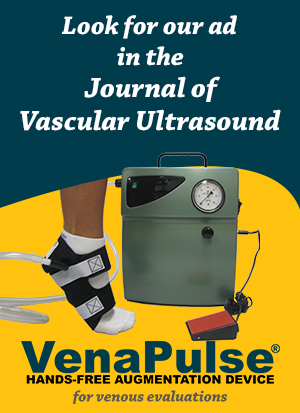Many vascular technologists today use manual augmentations to perform venous reflux exams. Augmentations to the study
patient’s leg are essential to the documentation of valves, but unfortunately, technologists only have two hands to operate the ultrasound machine, hold the wand to the desired location, and perform augmentations. Squeezing the patient’s leg manually can result in difficulties:
- A technologist’s hand may become tired or sore;
- The awkward positioning might strain a technologist’s body;
- Divided attention and discomfort widens the possibility for error
To reduce inconsistencies and provide a more comfortable experience for vascular technologists during venous reflux exams, ACI Medical has developed a foot-operated device that performs rapid and consistent augmentations: the VenaPulse® Hands-Free Augmentation Device. The picture on the right features Professor Nicos Labropoulos using the inflation cuff system during a demo at the Venous Symposium earlier this year. His left hand is free to operate the ultrasound. A published prospective study from 2009 compares the VenaPulse® device’s performance with traditional manual augmentations. Conclusion: The VenaPulse® device is just as effective as doing manual augmentations during venous reflux exams.
Prospective comparison of the pneumatic cuff and manual compression methods in diagnosing lower extremity venous reflux
Stavros K. Kakkos, MD, PhD, Judith C. Lin, MD, FACS, Jennifer Sparks, RVT, Melissa Telly, RVT, Michalene McPharlin, RN, RVT, and Daniel J. Reddy, MD, FACS. Vascular and Endovascular Surgery, Vol. 43 No. 5: pp. 480-484. http://ves.sagepub.com
Aim
To compare pneumatic cuff with manual compression in diagnosing reflux in patients with chronic venous insufficiency (CVI).
Patients and Methods
Eighteen patients (Clinical Etiologic Anatomic Pathophysiologic [CEAP 2-5], median Venous Clinical Severity Score [VCSS 6.5]) were studied. The VenaPulse device (ACI Medical, San Marcos, California) was used for cuff inflation. The hemodynamic performance of the 2 methods was tested in the first 9 patients, while their diagnostic value was tested in the last 9 patients.
Results
Both methods induced equal compression with median peak velocity of the antegrade flow (PVA) being 86 cm/s (P=.65). Coefficient of variation (CV) for PVA in the superficial veins was significantly higher with the manual method (16.8%) compared to the VenaPulse method (9.5%, P<.001), while sensitivity and specificity were 85% and 100%, and 78% (κ .68, P<.001) and 100%, respectively.
Conclusions
Pneumatic cuff and manual compression were shown to be equally effective in diagnosing venous reflux. Cost-effectiveness and ease-of-use studies comparing these methods are justified. Keywords: vascular lab; varicose veins; pneumatic compression







